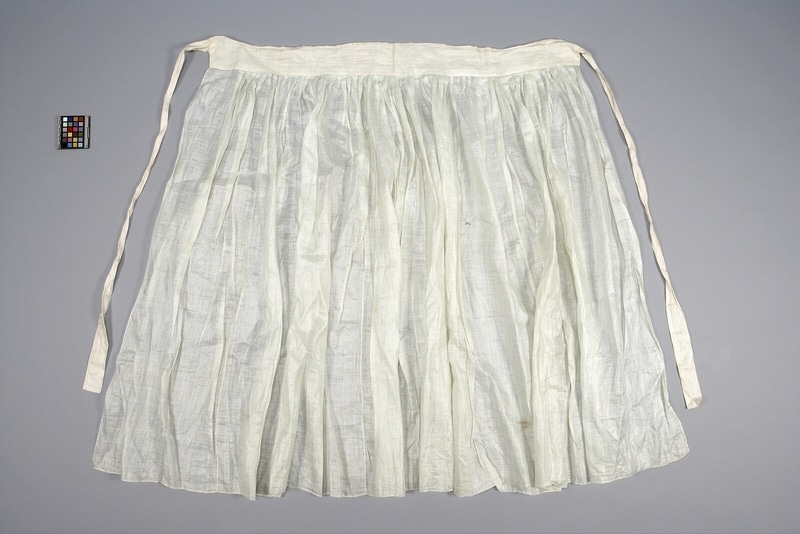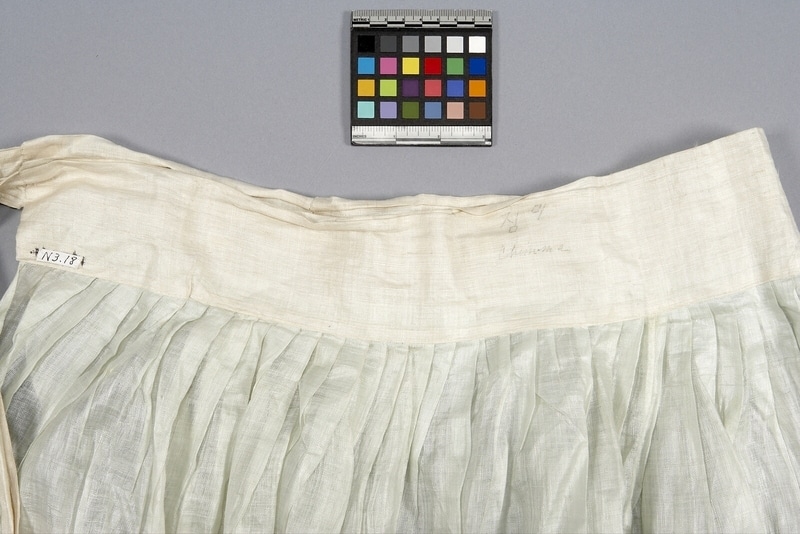Summer Skirt Item Number: N3.18 from the MOA: University of British Columbia


Description
Skirt of made of eight panels of pale green shiny, translucent silk open at the back. The skirt fabric is pleated onto a band of white silk, with long ties at both ends of the band made of ramie doubled over and sewn with stitches concealed inside. There is a smaller area at the top right upper edge with no pleats. On the left side the silk is inserted higher into the waistband, thus raising the bottom hem at this point. Roughly-written label in black ink in phonetic script and Korean characters on waistband.
History Of Use
Lightweight skirts were worn in summer. Skirts of such quality were worn by older women high class women (over age forty) or by very high class young women. Ordinarily younger women did not wear skirts of such quality, as they had to work. Such a skirt might have been worn by a prostitute, as it wraps in the opposite direction of normal skirts. Prostitutes at that time were wealthy. It also could have been underwear, as it would have been impractical to re-paste the hem and edges every time it was washed, but the colour is wrong for underwear. Skirts were worn with the band at the level of the wearer’s breasts. The ties were wrapped around once and tied in a single loop at the front. Skirts originally had no straps to hold them up, but the use of straps was encouraged by missionaries after the opening of Korea to the outside in about 1894, reflecting their ideas of decency. There were many kinds of “chima” from the late 19th century on. One lower edge was slightly raised by inserting the pleats higher into the waistband so the wearer would not trip.
Cultural Context
clothing
Iconographic Meaning
This type of translucent skirt, if worn with many layers of underwear, reflects the ideas of purity and eroticism.
Specific Techniques
The fabric was hand-woven and dyed with natural dye. Full loom widths of 35 cm. were used to make the panels, so that the selvedges form the edges of the seams, which thus require no further finishing. All the stitching is invisible. The waistband stitching shows only on the inside, not on the outside. All the edges are pasted. The seams are hand-sewn and pasted so that they will lie flat and go to one side. The pleats are carefully formed, 1.2 cm. each. The join of the ties to the waistband is done with skillful hand sewing.
Item History
- Made in Korea before 1939
- Collected between 1899 and 1939
- Owned by Marion Stephan before August 1964
- Received from Marion Stephan (Donor) during August 1964
What
- Name
- Summer Skirt
- Identification Number
- N3.18
- Type of Item
- skirt
- Material
- silk fibre, dye and paste adhesive
- Manufacturing Technique
- woven, dyed, cut, pleated, sewn and pasted
- Overall
- height 108.5 cm, width 136.0 cm
Who
- Culture
- Korean
- Previous Owner
- Marion Stephan
- Received from
- Marion Stephan (Donor)
Where
- Holding Institution
- MOA: University of British Columbia
- Made in
- Korea
When
- Creation Date
- before 1939
- Collection Date
- between 1899 and 1939
- Ownership Date
- before August 1964
- Acquisition Date
- during August 1964
Other
- Item Classes
- textiles
- Condition
- good
- Accession Number
- 0113/0068